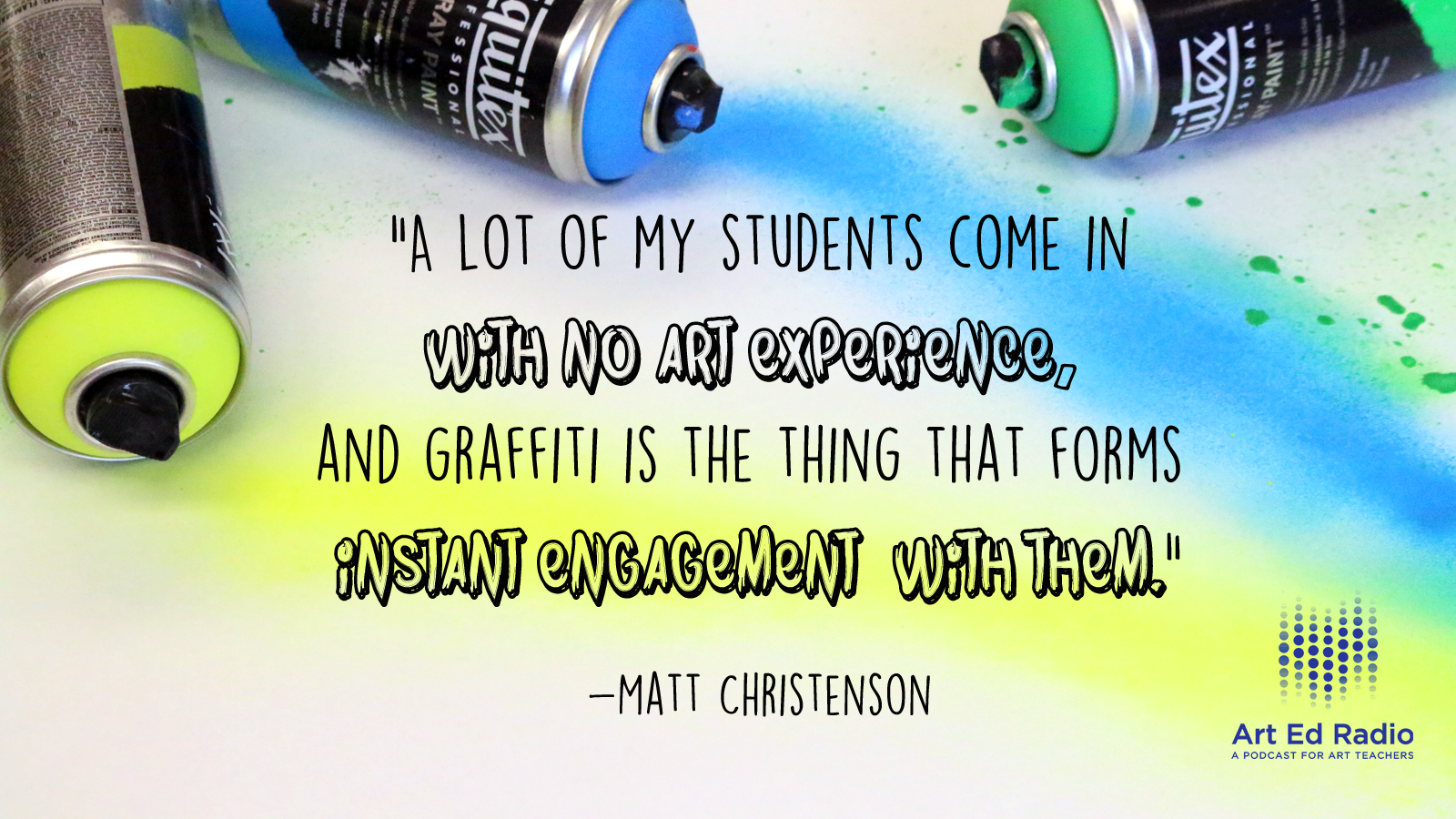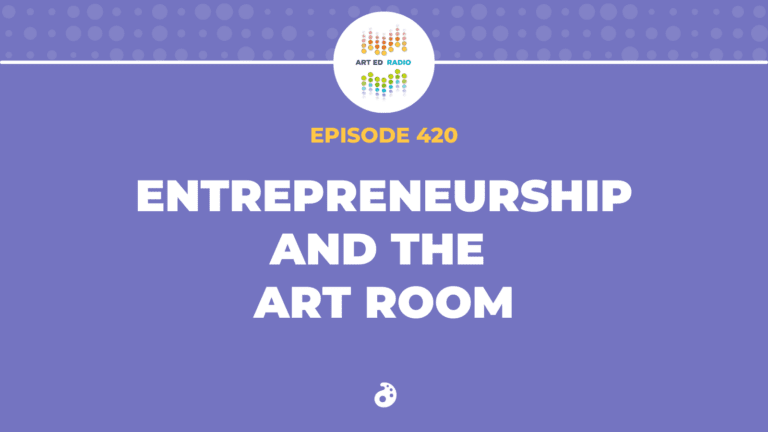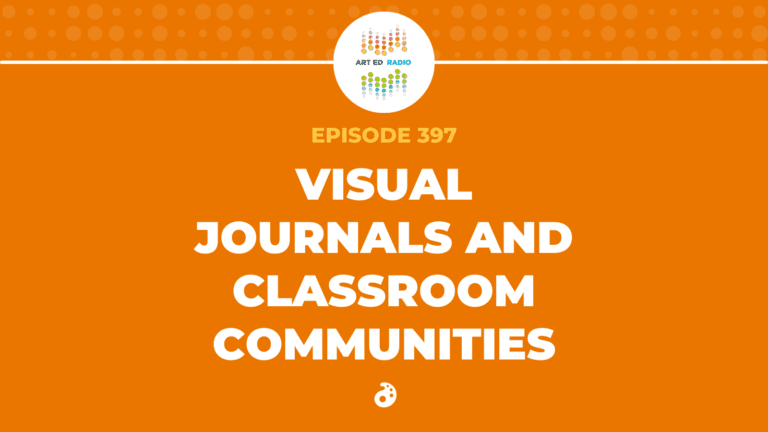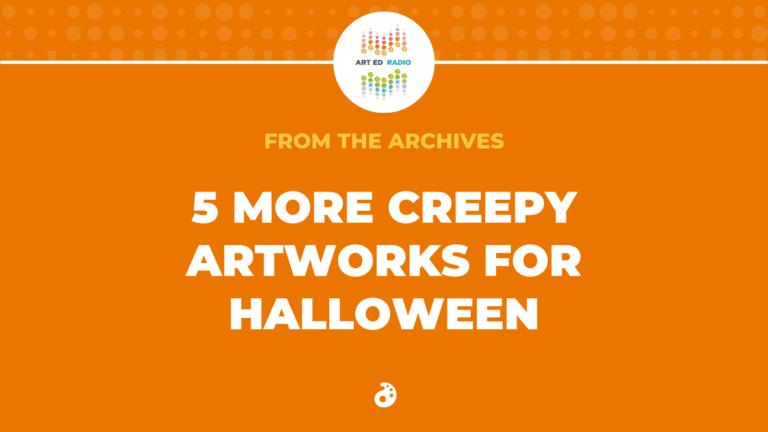Graffiti gets a terrible rap from most of the general public, but it is SO interesting to our students. So how can we use graffiti for student engagement and inspiration? AOE writer Matt Christenson is on the show to talk about how he uses graffiti in his curriculum and how his students respond. Listen as they talk about how graffiti helps connect almost every student (5:45), the structure of a graffiti-based curriculum (8:00), and Matt’s full rundown of assessment and critiques that happen in his classroom (14:45). Full episode transcript below.
Resources and Links:
- Matt’s very first AOE article about teaching graffiti
- How graffiti fits into a bigger curriculum
- Another article from Matt on how he runs some critiques
- And why he loves to display student work

Transcript
Welcome to Art Ed Radio, the podcast for art teachers. This show is produced by The Art of Education, and I’m your host, Tim Bogatz. Let’s talk about graffiti. It gets a terrible rap from so many people, and it’s always part of the public space. Sometimes welcome, but most of the time, not, and as amazing as it might look, far too many people see it as a nuisance or as a problem. The word graffiti in school settings can bring up those immediate feelings of danger or discomfort because graffiti has its roots in vandalism and it’s been illegal for a long, long time, but yet our students are so interested in it.
Maybe that element of danger has something to do with it, but my question, I guess, is, how can we harness that interest and turn that into student engagement and inspiration? How can we get kids creating artwork they love? Graffiti inspired studies can do so much for our kids, giving them a better knowledge of identity, of interdisciplinary content, of symbolism, metaphor, artistic conventions, and students can design all kinds of different graffiti, all of it dynamic, and they don’t even need to be using spray paint.
They can create work with markers, colored pencils, pastels, paint, okay, and a lot of these ideas come from Matt Christenson, who is an AOE writer and he’s going to be on the show today to talk about all of these ideas. He does some incredible things with graffiti in his classroom, and I want him to share some of the specifics of how you can incorporate graffiti in your classroom. If you’re one of those amazing teachers who attended Art Ed Now this winter, you actually saw Matt talk about his graffiti inspired curriculum. It was an awesome presentation, and actually, before I move on, I’m going to use that chance to talk about the next Art Ed Now Conference, the one that’s coming up this summer.
On August 3rd, we will have another wonderful line up of presenters, and I don’t want to give away all the secrets yet, but if you go to artednow.com, you can see the first six presenters and presentations we’ve released. We have some great talks coming on-makerspaces, choice-based teaching and a lot more, and if you’re a secondary teacher, I think one presenter that will really interest you is Michael Bell.
His kids do some flat out incredible work, and he’s going to show that as well as talk about his process that helps turn your beginning students into artists that are able to create with a powerful and a meaningful voice. That talk and the entire conference, really, is going to be well worth your time. Like I said, go to artednow.com to check out everything and make sure you sign up soon, while the price is still low. Right now you can take part in the entire conference for just $99, but let’s get back to Matt.
He’s got an incredible, in-depth process that teaches kids not only how to create graffiti but how to do it in a lot of different forms and different ways. He brings big ideas, like I said, the symbolism and the visual metaphors, to get his kids thinking as they’re creating. He also has some great ideas on assessment, reflection, and how to get your kids involved throughout the entire process. Matt has a lot to share and he is happy to share. He loves talking about this stuff, and I can tell you, he will be genuinely excited if you use some of his ideas in your own classroom, so listen close to what he has to say, how he presents these ideas, how he gets his kids talking, sharing, collaborating, and think about what you can take back to your own classroom.
Okay, and then just one last quick note before we get into things. This interview’s going to sound a little different than normal because we recorded it live, in person, at the NAEA National Conference in New York City just a couple weeks ago, so you’ll hear a little bit of background noise and some of the hustle and bustle that happens when it’s such a busy conference. I think it creates a really cool ambience, a little shot of energy, and a nice bit of background noise, but there’s a lot of great information that Matt gives you throughout the talk, so let’s go ahead and give it a listen.
I’m here with Matt Christenson. Matt, can you tell us a little bit about where you teach and what you do?
Matt: Yeah. Hello, Tim. I teach at City Arts and Tech High School, tenth grade, Visual one class. That’s every kid in tenth grade has to come through me.
Tim: All right, nice, and you’re in San Francisco, right?
Matt: San Francisco, yes.
Tim: Okay. The question I always ask every guest, how are you today?
Matt: Thanks for asking. I am having a great time here. We’re at the NAEA Convention, and energy is high.
Tim: Yeah, I love that. I actually wanted to get Matt on the podcast because I went to his session at NAEA this morning, and it was a hit. You had a packed house, which was pretty awesome, and really vibrant talk about graffiti, everything you do, like how you teach it, so I guess I just want to start by asking you, with graffiti, why is that such an important part of your curriculum and why do your kids connect with it so well?
Matt: Yeah, that’s a great question. Well, a lot of my students come in with zero art experience, and I literally hear half the class tell me they’re afraid they’re going to fail art. For me, I want to bring something that’s really just, right away is going to hook them and it’s something that’s going to be, they have a little bit of prior knowledge, and so with graffiti, everybody has seen it all over the city and know the, some of the students know the artists. Some of the students are the artists, and so automatically when they say, we’re doing graffiti, they can make the connections. They have some ownership of the class already, and so it’s really engaging. That’s what I want, I always start the year off with that.
Tim: That’s cool, so let me ask you this, though. You have so many kids coming to you who don’t have art experience, that probably don’t know how to draw all that well, so how do you just dive into graffiti? Is there a strategy you have? I guess let me put it this way. How do you scaffold that? What do you start with to introduce them, and how do you build on that as you move through the curriculum?
Matt: Absolutely. First of all, we mirror the elements of art with the elements of graffiti, so students start off with just tag lettering. It’s just manipulating lines. We’re not going to get too crazy, too fancy, we’re just going to play with our hand a little bit and we’re going to move into throw letters, which have a little more shape to them, and then we’ll get to the more advanced sort of stylistic letters.
The first week, I like to give them dry erase boards and markers, and we just start with our initials and we design them in different ways, just using tag or line lettering. I do it with them, so I’ll give them an assignment to stack their letters or intertwine them or curve them or spiral them or write one big and one small, just loosen them up. We gradually get a little more advanced, so the second day, it’s like, all right, now we’re going to make this letter a throw letter, meaning it has shape, you can fill it in, and we start making our initials that way in various formats.
Then I start giving them the idea to overlap their letters, right? One’s in front of the other, the illusion of depth and space, and we just slowly just keep playing with that until we incorporate one point perspective. That’s an entire week, just to get them feeling confident and so they can see how they’re growing a little bit each day.
Tim: Yeah, that sounds really cool, and it sounds like, that your curriculum for the graffiti here is actually pretty structured and uses a lot of artistic conventions, I guess you would say, so can you talk a little bit more about, like once you have kids doing those throw letters, they’re thinking about depth, they’re thinking about perspective, how do you take it to the next level after that?
Matt: Well, that is definitely a great question. First of all, the artistic conventions in my unit I want students to be able to use and explain and everything would be overlapping, one point perspective, warm, cool, and neutral colors, complementary colors and gradation or value shifting, or shading. What I want to do is gradually give them more opportunities to use these different conventions through choice in their assignments.
After we do basic little scaffolding around basic color wheel and warm and cool and neutral and complementary colors, then it’s all about sticker assignments. Students get to show that they know these conventions, but then they choose how they design their stickers, right? Sometimes I’ll give them the requirements, such as, “All right, in this first sticker I want you to show me overlapping, and then second sticker, perspective, and then third sticker, all warm colors,” and so on and so forth. Then when they’re finished, then they get to use those different conventions however they want, experiment more. That’s where they get to just really shine and internalize those conventions.
Tim: Okay. That sounds really cool. Let me ask you, though. As you’re working kids through this process, through these, all these conventions, as a teacher how are you assessing that? How are you making sure that your kids are keeping up with all of these new things for them, and how are you making sure that they stay on track with what you’re learning and the pacing that you’re doing?
Matt: Yeah. Good question right there. For me, the most effective strategy I have is student conferencing, so while students are actively working, I don’t really, I try to build a culture of peer review, independent learning, so they ask each other as many questions as me. Ultimately, I like to have time where I call them over, one at a time, and they show me what they know for a minute.
I’ll ask them a series of questions around, can you show me the complementary colors? Can you tell me the warm, cool and neutral colors? Have them demonstrate in front of me what they can do, and then I take notes on that. Gather data that way, and when students struggle, then I know they need some more one on one attention. After I speak with everybody, I like to call back those other students, cycle back to them, and work with them a little bit more closely until I feel like they’re getting it.
Tim: Okay. That makes sense. I like that. Then you talked a little bit, just real quick, you touched on that peer review, so does that manifest itself with critiques and things like, are you doing that at the very beginning when you’re just starting with that, or do you wait until you get to some more advanced projects before you do critiques and do more of those peer reviews?
Matt: Yeah, I like to wait to do a critique until about three weeks in, so the basic stickers and real introductory scaffolding assignments, we don’t really critique those, but when we do the graffiti alphabet, which is the last chance for students to experiment with font and all the conventions before they have projects, we definitely have a critique there. That’s all around peer review culture, so I like to have them partner up and they go and critique different pieces on the other side of the room.
I set it up as a game, more like a battle. Then they write out something they like and suggestions they have for their peers, and then they present those in front of the class. I like to have them practice being the ones who have the knowledge and have good ideas and insight for each other as early as possible and continue that throughout the unit.
Tim: Okay. That’s really cool. I like that. I guess I want to circle back around to the scaffolding then, because you talk about the basic lettering, and then you get into the stickers. You get into the alphabet, and then, where do you go from there? When it is time to do projects, like once they’ve built up all this knowledge, you have a good grasp on the artistic conventions, where do you go for projects? What do you start to do then?
Matt: Well, now I want to give students choice, and graffiti is designing words and images, essentially. That’s where I like to start, is one word and one image. They get to choose that word. They get to choose that image, and then I want them to continue using these conventions but I like them to choose which ones they want to use. They got to choose three out of five in the first assignment. Basically that’s a great way, we’ve been doing scaffolding for three weeks now, and it’s, you got to cut them loose. It’s time for them to use it, right?
Tim: As long as they’re doing three out of, so if they do some sort of overlapping or depth, perspective, and use a quality color scheme, you’re good with that?
Matt: Absolutely.
Tim: Okay.
Matt: Yes, indeed, and then I can actually push them to try and use all of them.
Tim: Right.
Matt: Which a lot of students are, can easily do, and some need a little extra coaching, but yeah. Those are just, that’s where we start, for sure.
Tim: Okay, cool. Then, do you feel like kids take to that pretty well? Do they, are they able to transfer to a little more choice-based work, a little more choice and voice without a problem, just because you’ve done so much scaffolding?
Matt: Yeah. There’s definitely, when we start incorporating symbolism or visual metaphor, and even choosing a code name to represent their identity throughout this unit, we still need work. We still need introduction. We still need some team games so they can teach each other and share ideas together, but then yeah. Once it comes time for them to have two weeks of studio time, then it’s them, on their own, and with each other, in action.
Tim: Okay. That’s really cool. Now that you have these projects developed, kids have done really well with the identity piece or the visual metaphor, whatever that is, when those projects are getting finished, then can you talk a little bit about how you do your critiques, how you do the battles, as you call them? Explain to people what that looks like in your room.
Matt: Sure. Yeah, so the battles, basically I got six tables in my room. If you’re on one side of the room, three sets of tables, you’re one team. The other three tables are another team. I put a little piece of blue tape up on my wall to separate the two pieces of the board, and you’ve got to put your artwork up on whichever team’s side you are.
Then I like to give students a vocabulary sheet that has a lot of terminology that we’ve been using throughout the course, and they get in teams, or partners at their table, and they go and they fill out this sheet together. It’s a critique sheet, so they write things they like about a certain work and why. Very important, they have to say why that is, and the exact same thing as at first, they have to give a suggestion for improvement and why they think that would improve the work. They got to do that for two different people.
Then when we come back to our table groups to get ready to present, I make sure students who are going to be in teams, they have to, they can’t present on the same exact piece if they’re at the same table. If I have six students at one table, that would be three groups of two. They got to make sure they’re not going to come and present about the exact same piece. They got to have a little variety in there.
Tim: Right.
Matt: That’s essentially how it works. The last part would be about points, right? I give points. If everybody presents from that table, the whole table gets three points for their team. If people were talking in the audience, I take points away from their team, and basically the winner, I don’t tell them what the prize is. Sometimes it’s a piece of candy, but I really don’t like that. I like to just let them leave about 30 seconds early, and the other team has to watch them walk out.
Tim: Nice. I like that. Then, do you feel like the points incentivize things enough, because in my experience, high school kids hate presenting. They hate talking about work. They hate getting up in front of the class, so does the points system encourage them to do that? Does that make them more comfortable, or I guess, at least more willing to do that?
Matt: It makes them more willing, and it’s definitely not going to make them more comfortable.
Tim: Okay.
Matt: They hold each other accountable. That’s the reason why I really like the points, is for whatever reason, that little element of competition elevates the urgency, and so students keep each other in check. If I’m about to say, “Okay, audience, the presenters are ready. We’re going to take off points,” and I hear people say, “Okay, okay, stop, stop, stop, stop,” in the audience. They want to win.
Tim: Yeah. Sure.
Matt: For whatever reason, that helps out a lot.
Tim: Yeah. That’s really cool. Then I guess, last thing as far as projects go, I’m still interested in how you assess these things. Can you talk about, post critique, you do the grading process with your kids. Do you take projects home and grade them? Do you talk to them about what they’re doing with that? What does reflection look like for the kids and what does your grading look like?
Matt: Yeah, that’s a great question. For me, at this point, I use the one on one conferencing strategy again. Now we’re talking about the summative assessment of the work, and so I have students assess themselves using a rubric, so there’s various categories. Not too many, just basics around their word design, their artistic convention use, maybe their imagery use, and then my favorite is their effort, right? How much did they put in this project, and after they score themselves, which they do incredibly honestly because then I call them over and they have to explain it to me.
It’s really interesting to hear them reflect in front of me, and then I give them feedback in the moment, and I score the rubric right in front of them and give them my reasons why I did that. Then we come to a final score together and areas we can improve together, but one reason why I really like that is because I don’t grade ever outside of class. It’s always during class time, which frees me up on prep to do a lot of other things.
Tim: Nice. Yeah, and I think that’s something that every art teacher is looking for, is more time, right? One last question, and then I’ll let you get out of here. I know graffiti is just so much about public spaces and being out in the open. It’s different to try and teach this in the classroom. How often do you talk about graffiti that’s outside of the classroom, and do you ever see kids creating outside of there? Do you teach toward that so they know what to look for or what to do if they’re creating graffiti outside of your classroom?
Matt: Yeah. First I’ll just say I have never been a graffiti artist, so I’ve learned more from my students about it than any other source, right?
Tim: Right, right.
Matt: Yeah. My role has been to basically get out and document work in the city, go to my students’ neighborhoods with my camera and take photographs and bring those back to the room so that every day when we start class, we can examine the artistic conventions being used or the symbolism in the work, and just the, where it’s from. Give students a little pride that this is from where they’re from. This is their public art that they’re exposed to.
Then, in terms of doing work outside of class, a lot of students do already, but I still like to promote the idea that you want to do legal work. Even though we know graffiti comes from illegal pieces that people do, it’s all about, for me, promoting the idea that if you do legal work, which means you have the permission to do it on someone’s property or it’s your own property, you can make money that way. People can pay you for that kind of work, as opposed to, if you go out and just hit up somebody else’s property and you get caught for that, now we’re talking you’re paying, either through fines, through community service, or even jail time.
Tim: Yeah.
Matt: It’s great. Students like to say, “But it’s just art,” and it’s like, “Well, that’s cool, that’s your opinion, but then there’s the law involved, so if I were you, I would try and use the skills you’re learning now and get permission and maybe even have somebody pay you for it.”
Tim: Yeah. That’s really cool. I like that a lot. All right, well, we are up against it as far as time, but I appreciate you coming on. I think you have a lot of good insights that a lot of teachers are curious about, and I think they’ll appreciate you coming on and explaining everything you do, so thank you.
Matt: Absolutely. It’s been a lot of fun. Thanks, Tim.
Tim: All right, we’ll talk to you soon.
Matt: Ciao for now.
Tim: As promised, that is a lot of great information from Matt, not only about student engagement but about everything he does after the students are engaged. Matt has a great article that he wrote. I think it was his first article ever for AOE, and we’ll link it in the show notes, but it tells you about everything he does in his graffiti curriculum. I think that’s going to be a great addendum to the episode, so check out the website and the show notes if you want to learn even more from Matt.
If I can close with this, in the end, it’s not about graffiti necessarily. It’s about finding something, finding anything that works for the kids you teach. For Matt, that just happened to be graffiti, and for you, it could be anything at all. We need to find the subjects or the materials or the things that our kids can connect with. For a lot of my students, they always love doing portraits, okay, or they love experimenting with new materials, creating new projects, coming up with new ideas, okay, but just take some time to think about what your kids love. What they want to do, what they want to create, and honestly, it doesn’t matter what that is, it just matters that your kids are involved and they’re working and they’re excited about what they’re doing in class.
Then, once you have that engagement, it’s up to you as the teacher to extend that learning. That’s where reflections and assessment and big ideas come in. You need to figure out how you can push your students beyond that simple engagement, because once they are engaged, that’s only the beginning, okay? It’s up to you as the teacher to make sure that that real learning is taking place.
Art Ed Radio is produced by The Art of Education with audio engineering from Michael Crocker. Remember that you can sign up for our email list at artedradio.com. We also have all of our archives there, so you can check out every single episode we have recorded, and if you’ve listened to all of them already, you now have a chance to go back and listen to your favorites again. As always, we love to hear from you, so send any questions or comments or anything else you want to share with us to us at radioguys@theartofed.com. Thank you for listening.
Magazine articles and podcasts are opinions of professional education contributors and do not necessarily represent the position of the Art of Education University (AOEU) or its academic offerings. Contributors use terms in the way they are most often talked about in the scope of their educational experiences.



